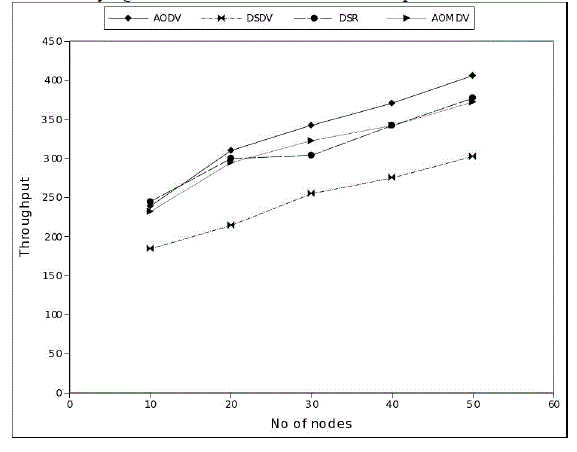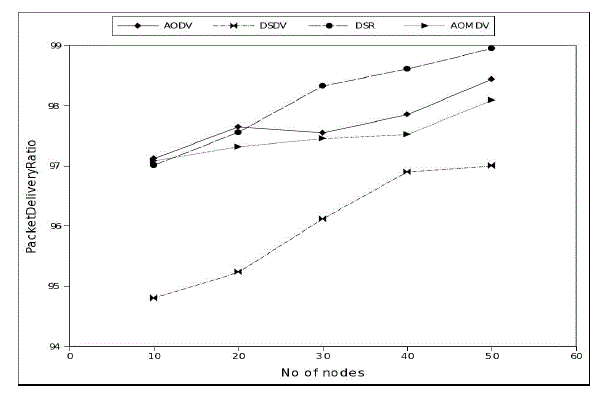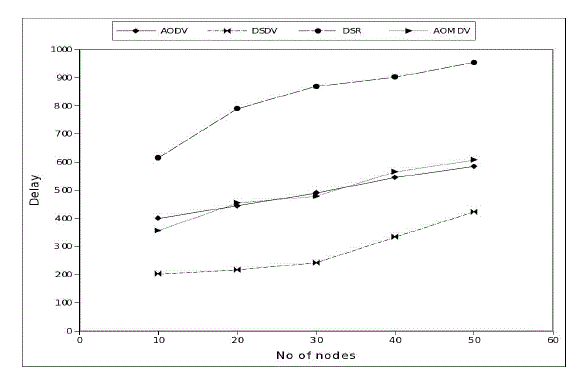Keywords
|
| AODV, DSDV, DSR, AOMDV, NS2 |
INTRODUCTION
|
| An adhoc wireless network consists of a set of mobile nodes (hosts) that are connected by wireless links. The network topology in such a network is such that it may keep changing randomly. Routing protocols which find a path to be followed by data packets from a source node to a destination node used in a traditional wired networks cannot be directly applied in adhoc networks due to |
| i) Their highly dynamic topology |
| ii) Absence of established infrastructure for centralized administration |
| iii) Bandwidth-constrained wireless links and |
| iv) Resource (energy) – constrained nodes. |
| A variety of routing protocols for adhoc wireless networks have been proposed in the recent past. This paper looks at the working of four such existing routing protocols – AODV,DSDV,DSR and AOMDV along with their simulation results. |
BACKGROUND
|
| Routing protocols for ad hoc wireless networks can be classified into several types based on different criteria. This paper looks at the more popular classification which is based on the Routing Information Update Mechanism.Based on this mechanism, the adhoc wireless network routing protocols can be classified into three major categories: |
| i) Proactive or Table-Driven routing protocols: |
| Here, every node maintains the network topology information in the form of routing tables by periodically exchanging routing information. This information is generally flooded in the whole network. So whenever a node requires a path to a destination, it just runs an appropriate path-finding algorithm on the topology information it maintains. |
| ii) Reactive or On-Demand routing protocols: |
| All the protocols which fall under this category do not maintain the network topology information. The desired path is obtained only when its required, by using a connection establishment process. |
| iii) Hybrid routing protocols: |
| In this category, the protocols just combine the best features of the above two categories. But in this paper, we won’t be looking at any protocol from this category. We will be looking at one proactive protocol – DSDV and three reactive protocols – AODV, DSR and AOMDV. |
| Destination Sequenced Distance –Vector Routing Protocol (DSDV): DSDV is one of the first protocols proposed for ad hoc wireless networks. It was mainly proposed to overcome the routing problem of Routing Information Protocol(RIP). It adds a new attribute, sequence number, to each route table entry of the conventional RIP. Based on the distributed Bellman-Ford algorithm, it was developed by C. Perkins and P.Bhagwat in 1994. Here, each node maintains a table that contains the shortest distance and the first node on the shortest path to every other node in the network. It incorporates table updates with increasing sequence number tags to prevent loops, to counter the count-toinfinity problem, and for faster convergence. |
| Dynamic Source Routing Protocol(DSR): DSR is an on-demand protocol which was designed to restrict the bandwidth consumed by control packets in ad hoc wireless networks by eliminating the periodic table update messages required in the table driven approach. The main difference between this protocol and the other on-demand routing protocols is that DSR is beacon-less i.e, it doesn’t require periodic hello packet transmissions, which are used by a node to inform its neighbours of its presence. |
| DSR has only two major phases, which are Route Discovery and Route Maintenance. Route Reply would only be generated if the message has reached the intended destination node. |
| To return the Route Reply, the destination node must have a route to the source node. If the route is in the Destination Node's route cache, the route would be used. Otherwise, the node will reverse the route based on the route record in the Route Request message header (this requires that all links are symmetric). In the event of fatal transmission, the Route Maintenance Phase is initiated whereby the Route Error packets are generated at a node. The erroneous hop will be removed from the node's route cache; all routes containing the hop are truncated at that point. Again, the Route Discovery Phase is initiated to determine the most viable route. |
| Ad Hoc On-Demand Distance-Vector Routing Protocol( AODV): The AODV Routing Protocol is an on-demand protocol for finding routes, i.e, a route which is established only when it is required by a source node for transmitting data packets. It employs destination sequence numbers(DestSeqNum) to identify the most recent path. The main difference between AODV and DSR is that DSR uses source routing in which a data packet carries the complete path to be traversed. But, in AODV, the source node and the intermediate nodes store the next-hop information corresponding to each flow for data packet transmission. In any reactive protocol, the source node floods the RREQ packet in the network when a route is not available for the desired destination. It may obtain multiple routes to different destinations from a single RREQ. The main difference between AODV and other reactive protocols is that it uses a DestSeqNum to determine an up-to-date path to the destination. A node updates its path information only if the DestSeqNum of the current packet received is greater or equal than the last DestSeqNum stored at the node with smaller hopcount. |
| A RREQ carries the source identifier (SrcID), the destination identifier (DestID), the source sequence number (SrcSeqNum), the destination sequence number(DestSeqNum), the broadcast identifier (BcastID), and the time to live (TTL) field. DestSeqNum indicates the freshness of the route that is accepted by the source. When an intermediate node receives a RREQ, it either forwards it or prepares a RREP if it has a valid route to the destination. The validity of a route at the intermediate node is determined by comparing the sequence number at the intermediate node with the destination sequence number in the RREQ packet. If a RREQ is received multiple times, which is indicated by the BcastID-SrcID pair, the duplicate copies are discarded. All intermediate nodes having valid routes to the destination, or the destination node itself, are allowed to send RREP packets to the source. Every intermediate node, while forwarding a RREQ, enters the previous node address and itsBcastID. A timer is used to delete this entry in case a RREP is not received before the timer expires. This helps in storing an active path at the intermediate node as AODV does not employ source routing of data packets. When a node receives a RREP packet, information about the previous node from which the packet was received is also stored in order to forward the data packet to this next node as the next hop toward the destination. |
| Ad Hoc On-Demand Multipath Distance-Vector Routing Protocol( AOMDV): The key concept in AOMDV is to calculate multiple loop-free paths between source and destination in each route discovery. With the availability of multiple redundant paths, the protocol can switch to an alternate path in case an earlier path fails. Thus a new route discovery will be needed only when all the routes fail. This results in a fewer number of route discoveries, and a considerable reduction in delay and routing overhead. |
EXPERIMENTAL SETUP AND SIMULATION RESULTS
|
| The experiments are carried out in an NS2 environment to simulate the ad hoc network. The simulation parameters like number of nodes, simulator areas etc. are given in the table along with their respective values. |
| Based on various parameters, the four protocols mentioned in the paper – AODV, DSDV, DSR and AOMDV are simulated and analysed for comparison. The performance metrics used for the evaluation purposes are: |
| i) Average Throughput |
| ii) Packet Delivery Ratio |
| iii) End-to-End Delay |
| Average Throughput:Average throughput indicates the amount of data received by the destination in unit time. It can be obtained by taking the ratio of the total size of the packets received at the destination to the total simulation time. The throughput is calculated for varying number of nodes for all the four protocols and the comparison is given below. |
| From the figure, we can analyse that the throughput of DSR and AOMDV is almost similar whereas that of AODV is slightly higher. Higher the value of throughput, more efficient is the protocol. And DSDV expectedly has the least throughput amongst the four protocols given that it’s a table-driven protocol whereas the rest are on-demand protocols. |
| Packet Delivery Ratio(PDR):Packet Delivery ratio is the ratio of the total number of legitimate packets received at the destination to the total number of legitimate packets sent from the source. A high ratio of PDR is an indication of a good performance of a protocol. |
| From the graph analysis, its clear that once again DSDV lags behind the other three reactive protocols which are almost equal to unity. It can be concluded from the graph that DSR is slightly better than AODV and AOMDV when it comes to PDR. |
| End-to-End Delay:End-to-End Delay is the total time taken by a data packet to arrive at the destination from the source. It also includes the time consumed by all possible delays caused by route discovery processes, the queue in data packet transmissions, the retransmission procedures, propagation delays etc. Only those data packets that have been successfully received at the destination are counted. The comparison of the delays of the four protocols is given below. |
| Lower the value of the end-to-end delay, the better is the performance of the protocol. Although the DSDV routing protocol had the worst Packet delivery ratio, it does route the data packets to the destination with the lowest Average End-to-End delay due to the availability of route to all destinations at all times in the route setup process. AOMDV and AODV have comparatively higher End-to-End delays while the DSR routing protocol has the highest delay among them all. |
CONCLUSION
|
| In this paper performance analysis of four routing protocols – AODV, DSDV, DSR and AOMDV have been done on the basis of three different performance metrics - average throughput, packet delivery ratio and end-to-end delay . The simulation results show that all the on-demand protocols fare better than the table-driven protocol DSDV. This could be due to the fact that DSDV suffers from excessive control overhead that’s proportional to the number of nodes in the network and therefore isn’t scalable in ad hoc wireless networks., which have limited bandwidth and whose topologies are highly dynamic. DSR eliminates the need the need to periodically flood the network with table update messages which are required in DSDV, but the disadvantage of this protocol is that the route maintenance mechanism doesn’t locally repair a broken link. Also, the connection setup delay is higher than in table-driven protocols, which explains its high end-end delay. This is why AODV and AOMDV, with a good average throughput and PDR and a comparatively less end-end delay, may have a slight advantage over other protocols. |
Tables at a glance
|
 |
| Table 1 |
|
Figures at a glance
|
 |
 |
 |
| Figure 1 |
Figure 2 |
Figure 3 |
|
References
|
- B.S.Manoj, C.Siva Ram Murthy “Ad Hoc Wireless Networks: Architectures and Protocols”.
- ManishaNiraj, Manoj Arora “ Performance Evaluation Of Routing Protocols For QOS Measures In MANETS”, IJMIE, Vol 2: Issue 4, ISSN: 2249 – 0558, April 2012
- Mina VajedKhiavi, ShahramJamali, “Performance Comparison of AODV and AOMDV Routing Protocols in Mobile Ad Hoc Networks”, International Research Journal of Applied and Basic Sciences ISSN 2251-838X / Vol, 4 (11): 3277-3285
- Perkins, C.; Belding-Royer, E.; Das, S. (July 2003). Ad hoc On-Demand Distance Vector (AODV) Routing. IETF. RFC 3561
- Perkins, Charles E. and Bhagwat, Pravin (1994). Highly Dynamic Destination-Sequenced Distance-Vector Routing (DSDV) for MobileComputers
- www.wikipedia.org
|